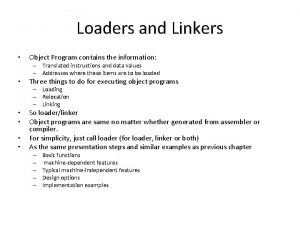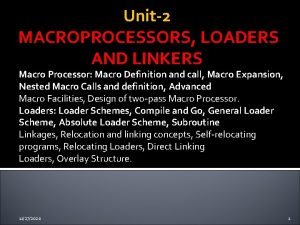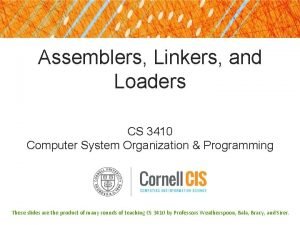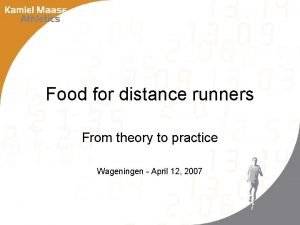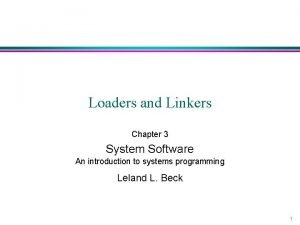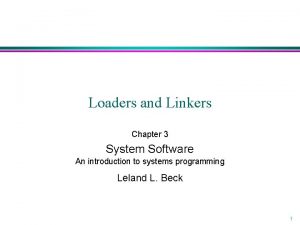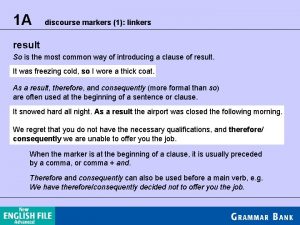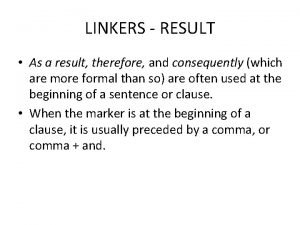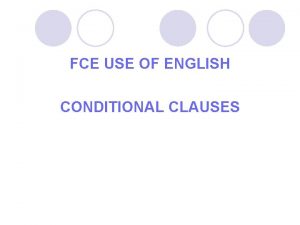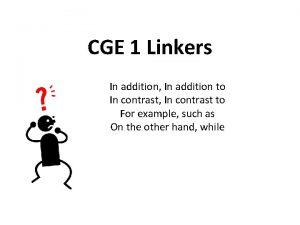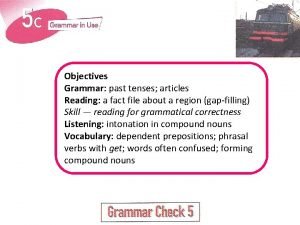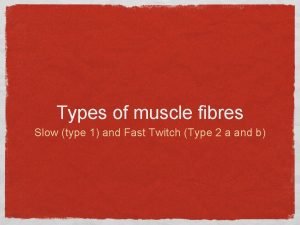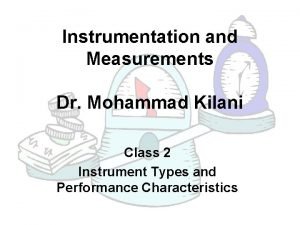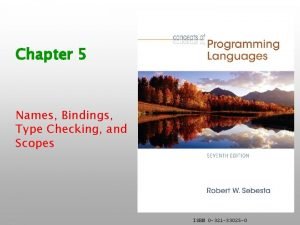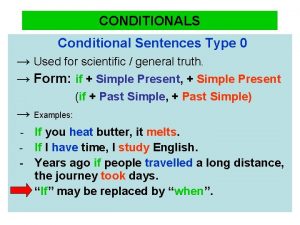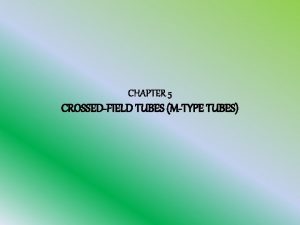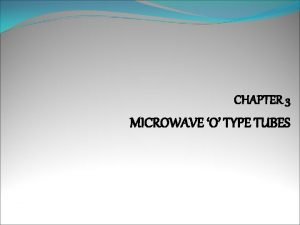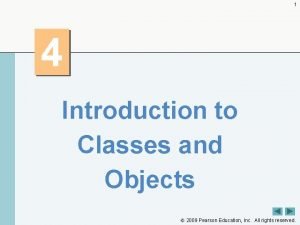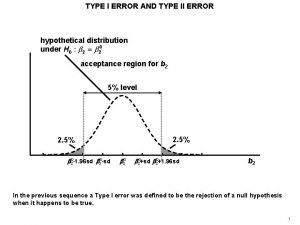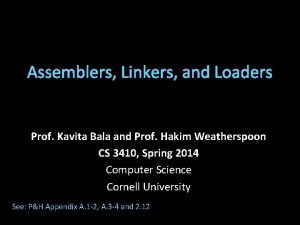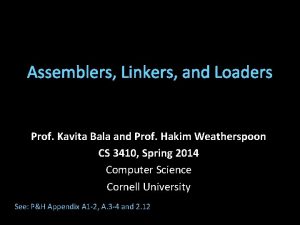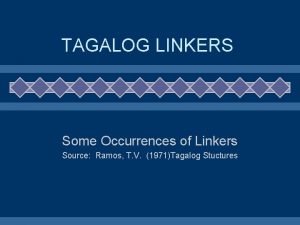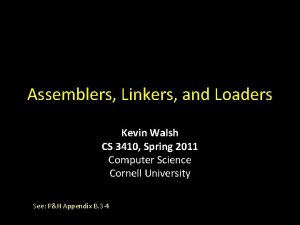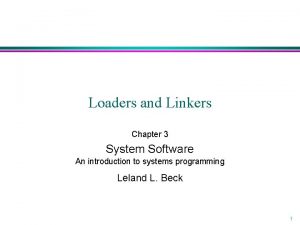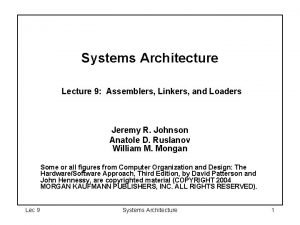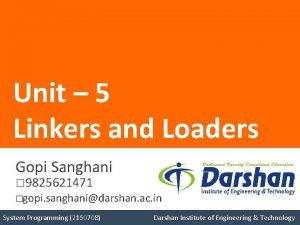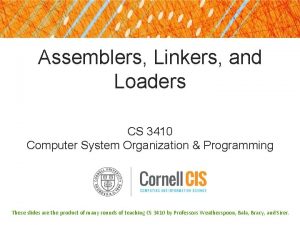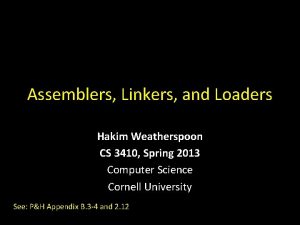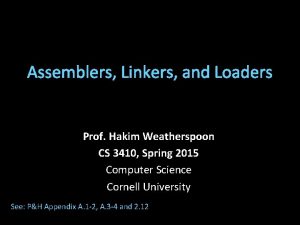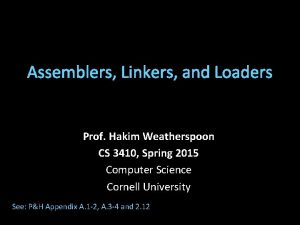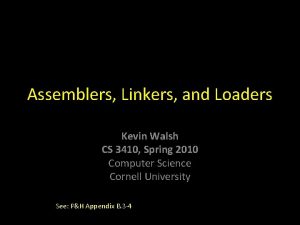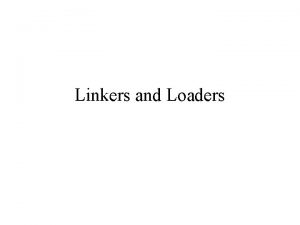Loaders and Linkers Overview n Type of loaders




































- Slides: 36

Loaders and Linkers

Overview n Type of loaders n n absolute loader (bootstrap loader) relocating loader (relative loader) direct linking loader Design options n n n linkage editors dynamic linking bootstrap loaders

Introduction To execute an object program, we need 1. Loading and Allocation, which n 2. 3. allocates memory location and brings the object program into memory for execution Relocation, which modifies the object program so that it can be loaded at an address different from the location originally specified Linking, which combines two or more separate object programs and supplies the information needed to allow references between them

Design of an Absolute Loader n Absolute Program n Advantage n n Simple and efficient Disadvantage the need for programmer to specify the actual address n difficult to use subroutine libraries n

Algorithm for an absolute loader Begin read Header record verify program name and length read first Text record while record type is not ‘E’ do begin {if object code is in character form, convert into internal representation} move object code to specified location in memory read next object program record end jump to address specified in End record end

Object Code Representation n each byte of assembled code is given using its hexadecimal representation in character form n n easy to read by human beings In general n n n each byte of object code is stored as a single byte most machine store object programs in a binary form we must be sure that our file and device conventions do not cause some of the program bytes to be interpreted as control characters

Loading of an absolute program

Loading of an absolute program

A Simple Bootstrap Loader n n n When a computer is first tuned on or restarted, a special type of absolute loader, called bootstrap loader is executed This bootstrap loads the first program to be run by the computer -- usually an operating system Example (SIC bootstrap loader) n n n The bootstrap itself begins at address 0 It loads the OS starting address 0 x 80 No header record or control information, the object code is consecutive bytes of memory

SIC Bootstrap Loader Logic Begin X=0 x 80 (the address of the next memory location to be loaded Loop A GETC (and convert it from the ASCII character code to the value of the hexadecimal digit) save the value in the high-order 4 bits of S A GETC combine the value to form one byte A (A+S) store the value (in A) to the address in register X X X+1 GETC A read one character End 0~9 : 48 if A=0 x 04 then jump to 0 x 80 if A<48 then GETC A~F : 65 A A-48 (0 x 30) if A<10 then return A A-7 (48+7=55) return

Bootstrap loader for SIC/XE

Relocating Loaders n Motivation n efficient sharing of the machine with larger memory and when several independent programs are to be run together support the use of subroutine libraries efficiently Two methods for specifying relocation n n modification record relocation bit each instruction is associated with one relocation bit n these relocation bits in a Text record is gathered into bit masks Fig 3. 4 n

Modification Record n n For complex machines Also called RLD specification n Relocation and Linkage Directory Modification record col 1: M col 2 -7: relocation address col 8 -9: length (halfbyte) col 10: flag (+/-) col 11 -17: segment name

Object program with relocation by Modification records. H^COPY ^000000^001077 T^000000^1 D^17202 D^69202 D^4 B 101036^032026^290000^33200 7^4 B 10105 D^3 F 2 FEC^032010 T^00001 D^13^0 F 2016^010003^0 F 200 D^4 B 10105 D^3 E 2003^454 F 46 T^001036^1 D^ B 410^ B 400^ B 440^75101000^ E 32019^332 FFA^ DB 2013^ A 004^332008^57 C 003^ B 850 T^001053^1 D^3 B 2 FEA^134000^4 F 0000^ F 1^ B 410^774000^ E 32011^332 FFA^53 C 003^ DF 2008^ B 850 T^001070^07^3 B 2 FEF^4 F 0000^05 M^000007^05+COPY M^000014^05+COPY M^000027^05+COPY E^000000

Relocation Bit n n For simple machines Relocation bit n n n Text record col 1: T col 2 -7: starting address col 8 -9: length (byte) necessary col 10 -12: relocation bits col 13 -72: object code 0: no modification is 1: modification is needed Twelve-bit mask is used in each Text record n n n since each text record contains less than 12 words unused words are set to 0 any value that is to be modified during relocation must coincide with one of these 3 -byte segments n n e. g. line 210 Fig 3. 6

mask. H^COPY ^000000^00107 A T^000000^1 E^FFC^140033^481039^000036^280030^300015^481 061^3 C 0003^00002 A^0 C 0039^00002 D T^00001 E^E 00^0 C 0036^481061^080033^4 C 0000^454 F 46^00000 3^000000 T^001039^FFC^040030^000030^E 0105 D^30103 F^ D 8105 D^280030^301057^548039^2 C 105 E^38103 F T^001057^0 A^800^100036^4 C 0000^ F 1^001000 T^001061^19^FE 0^040030^E 01079^301064^508039^ DC 1079^2 C 0036^381064^4 C 0000^05 E^000000

Program Linking n Goal n n Resolve the problems with EXTREF and EXTDEF from different control sections Example n Use modification records for both relocation and linking n Address constant n External reference







Program Linking Example

Program Linking Example n Load address for control sections n n 63 7 F 51 Load address for symbols n n PROGA 004000 PROGB 004063 PROGC 0040 E 2 LISTA: PROGA+0040=4040 LISTB: PROGB+0060=40 C 3 LISTC: PROGC+0030=4112 REF 4 in PROGA n n n ENDA-LISTA+LISTC=14+4112=4126 T 0000540 F 000014 FFFFF 600003 F 000014 FFFFC 0 M 00005406+LISTC



Algorithm and Data Structure n Two Passes Logic n n n Pass 1: Assign addresses to all external symbols Pass 2: Perform the actual loading, relocation, and linking ESTAB (external symbol table) + +

Pass 1 Program Logic n Pass 1: n n Variables n n n assign addresses to all external symbols PROGADDR (program load address) from OS CSADDR (control section address) CSLTH (control section length) ESTAB Fig. 3. 11(a) n Process Define Record


Pass 2 Program Logic Pass 1: perform the actual loading, relocation, and linking Modification record lookup the symbol in ESTAB End record for a main program transfer address Fig. 3. 11(b) Process Text record and Modification record


Improve Efficiency n Use local searching instead of multiple searches of ESTAB for the same symbol n n n Implementation n assign a reference number to each external symbol the reference number is used in Modification records 01: control section name other: external reference symbols Example n Fig. 3. 12



 Linkers examples
Linkers examples Macroprocessors
Macroprocessors Assemblers and loaders
Assemblers and loaders Six rulers football team
Six rulers football team The theory and practice of lunch
The theory and practice of lunch Estab in system software
Estab in system software Linkage editor in system software
Linkage editor in system software Extref and extdef
Extref and extdef Markers and linkers
Markers and linkers Linkers for result
Linkers for result Type 3 conditionals
Type 3 conditionals 1-1 first conditional & time clauses
1-1 first conditional & time clauses Linkers for conditionals
Linkers for conditionals Linkers for addition
Linkers for addition Complete as sentenças usando os seguintes linkers if as
Complete as sentenças usando os seguintes linkers if as Read the theory box then choose the correct word
Read the theory box then choose the correct word Order of recruitment of muscle fiber types
Order of recruitment of muscle fiber types Type 1 error vs type 2 error example
Type 1 error vs type 2 error example Type a and type b personality theory
Type a and type b personality theory Sublimation defense mechanism
Sublimation defense mechanism Null type and deflection type instruments
Null type and deflection type instruments Slidetodoc
Slidetodoc Type checking and type conversion in compiler design
Type checking and type conversion in compiler design O blood type and b blood type offspring
O blood type and b blood type offspring Blood type and body type
Blood type and body type Name type compatibility and structure type compatibility
Name type compatibility and structure type compatibility Conditional type 0 examples
Conditional type 0 examples M type microwave tubes
M type microwave tubes Lead inductance effect in microwave
Lead inductance effect in microwave Reference type and value type
Reference type and value type Type 2 error
Type 2 error Bunch type groundnut
Bunch type groundnut Overview of transcription and translation
Overview of transcription and translation Data quality and data cleaning an overview
Data quality and data cleaning an overview Carbon family
Carbon family An overview of data warehousing and olap technology
An overview of data warehousing and olap technology What is bioinformatics an introduction and overview
What is bioinformatics an introduction and overview
